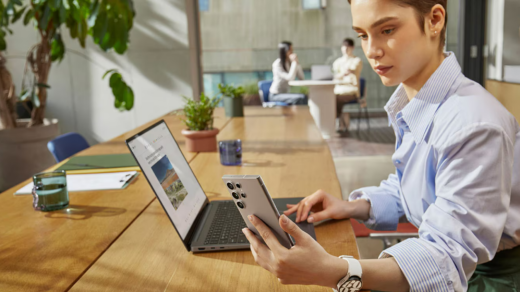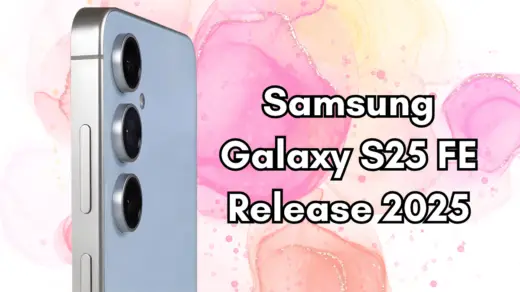Three months after the Samsung Galaxy Z Fold 6 hit the market, one thing is clear: it’s not just a foldable; it’s a whole new experience. Foldable phones have changed how we interact with our devices, and the rivalry between Samsung’s Galaxy Z Fold 6 and Google’s Pixel 9 Pro Fold is hotter than ever. But after three months of use, it’s the Galaxy Z Fold 6 that emerges with a few tricks up its foldable sleeve.
Flex Mode: The Ultimate Game-Changer
When it comes to foldable phones, how you use the screen is a huge deal. Enter Samsung’s Flex Mode—the feature that lets you use apps with the screen folded halfway at a 90-degree angle. You can prop it up like a mini laptop without any extra kickstand, making it super handy for multitasking. Whether you’re snapping pictures, watching videos, or managing your Spotify playlists, Flex Mode takes full advantage of the foldable form factor.
The Pixel 9 Pro Fold? It has Tabletop Mode, but it doesn’t quite live up to the same level of app support. On Google’s foldable, only a select few apps behave as they should when folded. The rest just stretch awkwardly across the screen, making the experience feel less refined.
In a world where foldables are still evolving, Samsung has clearly figured out how to make Flex Mode more than just a gimmick. You can even use the bottom half of the screen as a touchpad—turning your phone into a miniature laptop. This is a major win for anyone who loves to multitask, whether you’re catching up on work emails or managing group chats while binge-watching Netflix.
That Gorgeous Display: The True Star of the Show
Let’s talk about that stunning display. Yes, the Pixel 9 Pro Fold might sport a larger 8-inch screen compared to the Z Fold 6’s 7.6-inch display, but size isn’t everything. The Galaxy Z Fold 6 is brighter, sharper, and just feels better. Indoors, at half brightness, Samsung’s AMOLED display is visibly more vibrant, making it the perfect screen for long reading or streaming sessions.
Even in the sunlight, both phones perform decently, but when it comes to comfort during day-to-day use, the Z Fold 6 takes the crown. It’s not just about specs—it’s about how enjoyable the experience is. The contrast, colors, and sharpness all come together in a way that just feels right.
Galaxy AI: A Taste of the Future
Samsung’s Galaxy AI is fun to play with, offering some cool features like turning selfies into AI-generated artworks and creating polished images from rough sketches. Sure, they’re neat party tricks, but they haven’t yet become indispensable. However, features like Circle to Search, which lets you search the web by simply circling objects on your screen, hint at the potential for foldables to be more than just flashy tech.
The good news? Samsung is just scratching the surface with Galaxy AI, and there’s no doubt that future updates will bring more practical, everyday uses to the table. Until then, some of these features remain in the novelty zone—but it’s a novelty we can see becoming essential soon.
The Camera Showdown: Samsung’s Style vs. Google’s Precision
What’s a phone in 2024 without a stellar camera? Both the Galaxy Z Fold 6 and Pixel 9 Pro Fold come equipped with impressive shooters, but there are some noticeable differences in performance.
If you’re all about zoom, Google’s Pixel 9 Pro Fold shines. At 20x zoom, Google’s AI-driven magic ensures less noise and sharper details—perfect for capturing distant landscapes or intricate details. The Galaxy Z Fold 6 doesn’t quite match Google’s precision here, but where it excels is in capturing people. Whether it’s portraits taken at night or candid shots in a dimly lit bar, Samsung’s photos feel richer and more vibrant.
In short: Pixel’s photos are stunningly accurate, but Samsung’s photos have a bit more soul. Sometimes, a little warmth goes a long way, especially when capturing those moments that matter.
Battery Life: Keeping the Fold Open Longer
Foldables aren’t known for their amazing battery life, but the Galaxy Z Fold 6 holds its own. After three months of daily use, it’s proven to last longer than its Google rival in video streaming tests. After three hours of streaming at full brightness, the Z Fold 6’s battery dropped to 82%, beating the Pixel 9 Pro Fold’s 76%.
While both devices still trail behind non-foldable phones like the Galaxy S24 Ultra in terms of battery efficiency, the Z Fold 6 manages to offer solid performance, ensuring you won’t be scrambling for a charger mid-day.
Design Wars: Bigger Screens or Sleeker Folds?
The design of a foldable phone can make or break the user experience. Samsung’s Z Fold 6 has refined its design over the years, with a more symmetrical cover screen and lighter build. However, Google’s wider cover screen on the Pixel 9 Pro Fold makes it feel more like a regular phone when closed—something Samsung’s narrower display can’t quite offer.
But here’s the kicker: when unfolded, Google’s phone lies flatter, offering a sleeker, more tablet-like experience. Both phones still show visible creases, but it’s not a dealbreaker when you’re using them head-on. Design preference ultimately boils down to how you intend to use your foldable—Samsung for sleek, one-handed control, or Google for a larger, more natural display.
The Verdict: Why Galaxy Z Fold 6 Takes the Lead
So, three months in, how does the Galaxy Z Fold 6 hold up against the Pixel 9 Pro Fold? Both devices are expensive, both are packed with features, and both are a blast to use. But for sheer usability, Samsung edges out the competition.
If Flex Mode and superior app support are at the top of your list, the Z Fold 6 is the foldable you’ve been waiting for. Its ability to split the screen in innovative ways makes it more than just a phone; it’s a productivity powerhouse. On the other hand, if you’re after a foldable that feels more like a traditional phone with the advantage of larger screens, Google’s Pixel 9 Pro Fold might be more your style.
Either way, both devices are shaping the future of smartphones—and the best part? This is just the beginning.



